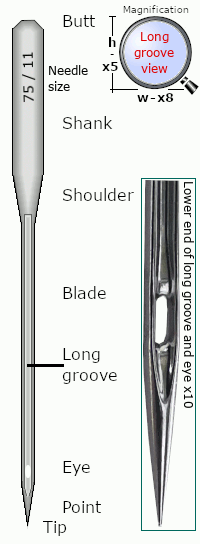The Needle
Small, sharp and highly specialised
The needle is a single structure, but it has several different specialised features so that it forms a successfully locked stitch. A seamstress with an understanding of the needle's parts and their function will find it easier to problem-solve stitch formation problems.

Let's look at the animation
For study purposes find a real needle and a simple plastic hand lens (magnification x10) to help you look at it. The animation shows a needle being turned slowly. We need to look all around the needle. As a real needle is so small the animation is also distorted so you can see it, the height is x5 and blade width is x8 of a real needle.
Points to note
- A good quality needle is highly polished. The eye in particular must look polished and smooth.
- The butt is the top end of the needle and has chamfered edges. This helps the operator locate it fully into the needle clamp.
- Flat face of the shank at the upper part of the needle. Machine instructions for inserting the needle often mention the flat face and the direction it must be facing when inserting a needle (NOTE: it's not the same for all sewing machines). The flat face is important for the needle clamp to work. This positioning also ensures the long groove, on other side of needle, lines up correctly with the thread.
- Coming down from the top, the Shoulder is where the 2mm shank is waisted down to the 1mm blade.
- The blade is the lower and thinner part designed to smoothly follow tip and point through the material
- The Long groove starts at top of the blade and runs down to the eye. The thread is guided by the material into groove which helps the thread easily penetrate the hole formed by the tip and widened by the point.
- The Scarf is a cut out in the blade (on same side as flat face), but very low down the blade and just above the eye. A Scarf is essential for loop formation and to allow a hook (moving part of a bobbin holder assembly) access to grab the formed loop.
- The Eye is highly polished. A damaged or rough eye will almost certainly snap the thread and the machine will only sew a few stitches or none!
- The material is penetrated by the tip and the point creates the hole. There are different specialised tips depending on the material being sewn. Needles do not last as long as some think. Needle life by Schmetz may give some clues
